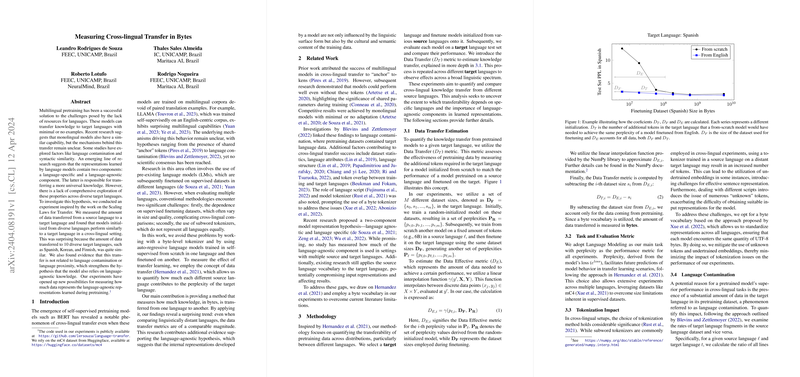Exploring the Mechanics Behind Cross-Lingual Transfer in LLMs
Introduction
The capability of LLMs (LMs) to learn language-agnostic representations that facilitate cross-lingual transfer has been a prominent area of research. Recent studies have concentrated on understanding how knowledge from a source language can be transferred to a target language effectively, even in the absence of extensive task-specific datasets in the target language. This paper investigates the underlying mechanisms of this transfer, focusing on whether models rely on language-agnostic knowledge and how this can be measured across diverse languages.
Methodology and Experiment Design
The research methodology is inspired by previous work on scaling laws for transfer learning, employing a novel metric, Data Transfer (), to quantify the volume of knowledge transferred from a source to a target language. This approach involves training models from scratch in one language and finetuning them in another, comparing their performance to models trained solely in the target language. By employing a byte-level tokenizer, the paper seeks to minimize biases introduced by tokenization processes and ensure a consistent comparison of data transfer between languages with varying scripts.
Results Overview
The experimental results reveal intriguing patterns of cross-lingual transfer, suggesting that the models are indeed leveraging language-agnostic representations to a significant extent. Notably, the amount of data represented by the language-agnostic components appears consistent across various source-target language pairs, even those considered linguistically distant. This consistency suggests that the models' ability to perform cross-lingual tasks does not solely rely on language-specific knowledge but also on a more universal understanding developed during pretraining.
Language Contamination and Similarity
The paper also examines potential factors influencing transfer efficiency, such as language contamination and linguistic similarity. Interestingly, the analyses found weak correlations between the efficiency of knowledge transfer and these factors, challenging the hypothesis that direct exposure to the target language during pretraining is a prerequisite for effective cross-lingual transfer.
Implications and Future Directions
This research contributes to a deeper understanding of the mechanisms enabling cross-lingual transfer in LMs, with practical implications for developing more efficient multilingual models. The findings suggest that focusing on cultivating language-agnostic representations could enhance the models' ability to generalize across languages, potentially reducing the necessity for extensive pretraining on vast multilingual corpora.
Looking ahead, the paper identifies several avenues for future research, including expanding the range of source languages, employing controlled datasets to address dataset heterogeneity, and exploring the transferability of non-natural language structures. These directions promise to further elucidate the dynamics of cross-lingual knowledge transfer and its applications in advancing natural language processing technologies.
Conclusion
In summary, this paper presents a comprehensive analysis of cross-lingual transfer in LLMs, highlighting the substantial role played by language-agnostic knowledge. Through meticulous experimentation and analysis, it offers valuable insights into how different languages contribute to the models' understanding and performance in target languages. As the field advances, these insights will undoubtedly inform the development of more sophisticated and efficient multilingual models.
